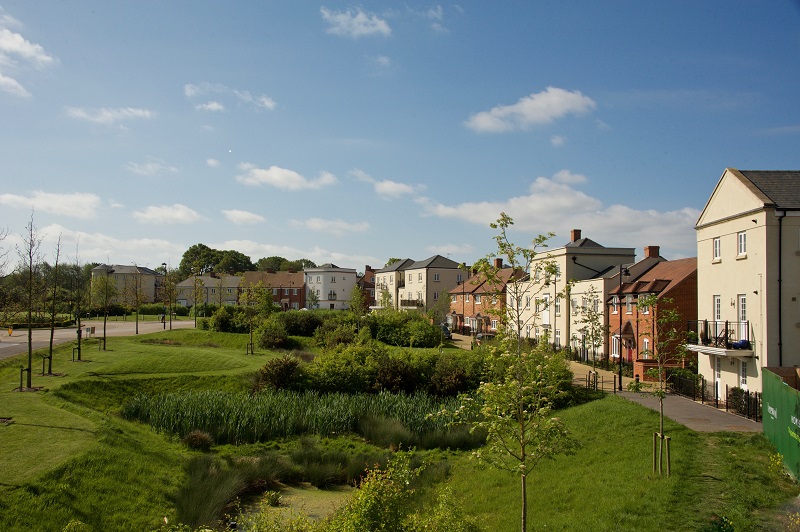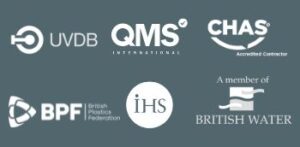Even with the best intentions, common approaches to SuDS design have made it all too easy for designers and developers to seize on a narrow understanding of devices that misses an opportunity to achieve their full potential for biodiversity with multiple benefits . While there are some exemplary schemes, others are completely missing the point.
You don’t have to visit many SuDS in England to observe how mixed they are in the quality of both their design and construction. In recent weeks, I have seen perfunctory SuDS on one site where the design delivered little benefit, but it ‘ticked the boxes’.
But on another site, I can see exemplary SuDS where the designer has worked around the existing habitat and topography and blended the site drainage with the existing ecosystem. As the proposed requirement for Biodiversity Net Gain evolves, I hope designers will become more skilled in habitat creation. I hope we will see more drainage designs with hedgerows, habitat corridors, insect habitat, ground-nesting bird sites on roofs and ground-breaking, wildlife-friendly landscapes where nature really can start to recover.
 Stereotypical SuDS
Stereotypical SuDS
Taking a too prescriptive view of using SuDS components to manage biodiversity has left us with stereotypical SuDS everywhere. These may manage flows or meet discharge rates, or are beautiful, separated green pockets, unable to deliver a connected green corridor that species need to thrive.
At the moment, I see too many SuDS schemes using roadside swales extensively, creating identical landscapes across England regardless of the local habitat conditions. Pure SuDS are, by nature, wetted environments, which support a particular set of habitats only. What kinds of species are we targeting with these devices? A recent report from the British Trust for Ornithology showed that urban birds are not thriving because there is not enough for them to eat; we can fix this with good SuDS design.
Sadly, I see far too many SuDS devices planted with grasses or reeds that are frequently mown to satisfy local expectations of a ‘tidy’ neighbourhood. That may be pleasing for the humans, but it will not benefit the SuDS, or the wildlife that come to depend on them, one bit.
Leave People Out of It
Why should it be all about the people? I saw a design for a large Green Roof in London the other day and it described how it would provide space for outdoor exercise and growing fruit & vegetables. Sounds fabulous – until you realise there was no mention of links to local habitats, and contributions to the ecosystem. If urban green spaces are always filled with people, illuminated at night, mown every week and pruned to ‘look nice’, what hope is there that wildlife will feel able to inhabit those spaces too?
So, here’s a slightly heretical proposition: There will be some sites where it is better to break apart the so-called four pillars of SuDS (quality, quantity, biodiversity and amenity), so that the benefits to wildlife are maximised. That may sound like heresy to some, but as long as all four are delivered, does it have to be by the same management train of devices?
We need to consider each site in the context of the local environment: Can we provide stepping stones for nature from one habitat to another? Can we extend that habitat for a local species? Can we draw new species into the development or introduce rare plants? This is all far more adventurous than the swales and basins of the past decade and it is a necessary shift if we are to mitigate the impacts of Climate Change and create beautiful places for people to thrive in and enjoy.
To achieve the required net gain, encouraging hedges, or heathland, native wildlife areas, even solitary bee habitats, might be better for the local conditions than a detention pond or swale. It might be best to extend a woodland next to a development. If it makes more sense, then provide flood resilience in an underground tank, and deliver biodiversity along a hedge perimeter, or wildlife meadow that supports important local habitats.
Let’s start thinking about genuine habitats for wildlife in SuDS designs. Habitats that are not maintained during the nesting season, or mown before wildflowers have had time to set seed. And habitats where the people are excluded, left undisturbed as much as possible. This must include habitats for the whole ecosystem; fungi in the soils, insects everywhere, bee habitats in sands & soils, scrub for bird nesting, a permanent supply of clean water, and wetted areas for reptiles and amphibians to keep cool. We need to see more hedgerows, more scrub, more meadowland, more sand piles and then the wildlife will come.
The role of humans in all this is one of custodian. We must create space for nature and then look after it. That doesn’t mean ferocious pruning, and it certainly mustn’t include herbicides and pesticides. But we must make sure that there is water to keep these habitats alive and well during long, hot, dry spells.
This is where a new role for SuDS can come in. SuDS schemes can be designed to capture rainwater, in tanks, ponds, butts or basins, and that water can then be used to keep habitats healthy. There are some great examples of ‘pocket parks’ where rainwater is captured and then used to irrigate the vegetation in the park. And at Southbank Place, in central London, an SDS rainwater harvesting system is being used to irrigate the landscaped area at Jubilee Gardens during the summer. By capturing the water and using it for irrigation, we can make serious savings of drinking water and the associated savings in carbon and lessen the burden on the water supply during hot, dry spells.
If we create it, then we must care for it. It’s time for a new role for SuDS.



